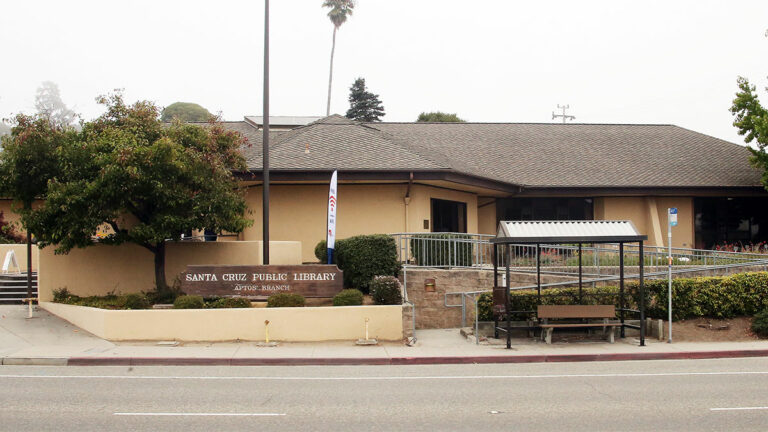This is part two of a two-part series on housing in Santa Cruz. — Editor
Author Conor Dougherty has started calling the housing crisis “our national local problem.”
In his book Golden Gates: Fighting for Housing in America, which came out earlier this year, Dougherty revisits the early days of the national housing crisis, starting from its epicenter in 1970s California, particularly the San Francisco Bay Area, and follows the ripples out across the rest of the United States. Economists have been documenting California’s housing shortage for more than 40 years. In the decades since, the state has only seen housing get more crowded and watched its homeless population grow, all while wealth inequalities continue to balloon across the nation.
Fixing a shortage of this kind isn’t as easy as simply erecting a crane or two and throwing a few hammers around, however. The politics can get tricky. In Golden Gates, Dougherty traces the cleavages that reshape the political coalitions in liberal coastal cities.
Discussions around plans for new growth, for example, can get messy quickly. Anti-gentrification activists—worried about displacement from an influx of new capital and residents—sometimes form unlikely partnerships with homeowners—who dislike tall buildings in the town they call home for purely aesthetic reasons. On the other side of these fights there are housing advocates, including ones who have, at times, failed to either grasp the power of such coalitions or to truly understand the fears of very low-income tenants who are already struggling to make ends meet and may not see the benefits of new high-rises.
Dougherty, an economics reporter for The New York Times, says what drew him to cover this problem was twofold: first, how its existence was universally acknowledged by everyone from former President Barack Obama to libertarian think tanks; and secondly, how no one really believed it could be solved.
“It starts to raise big questions about who we really are and what kind of society we’ve constructed and why,” Dougherty, whose book covers San Francisco, Silicon Valley and the East Bay, tells GT.
Here in Santa Cruz, there’s an overwhelming political consensus around the value of building affordable housing. That’s obviously a start, but because nothing is as simple as it seems, that does leave the door open to unresolved issues, like how many affordable units Santa Cruz will really be able to approve, who’s going to pay for them and how they will do so.
With Election Day arriving this week, here is a look at seven possible ideas from the Santa Cruz City Council race.
1. BUILD AFFORDABLE HOUSING WHERE POSSIBLE
There may only be one area where all nine candidates agree on housing policy. That’s probably as good a place as any other to begin.
All the candidates in the Santa Cruz City Council race support building 100% affordable housing, where possible, on city-owned land. This could lead to partnerships with a nonprofit housing developer, which could design new complexes for lower-income residents. Of course, building affordable housing is not as simple as simply convincing the City Council to wave a magic wand and approve the perfect project, using a giant big bucket of free money. Housing is expensive to build, especially when it’s made affordable to tenants. Paying the bill inevitably involves chasing down government, investor, crowdfunding, grant or community trust dollars. One of the major expenses involved in building, however, is the cost of land. By taking that cost out of the equation, the city could provide more bang for the buck—both for builders and for future tenants of good housing projects.
Even this area of agreement does, however, leave the door open for other questions.
For starters, how should Santa Cruz plan affordable housing buildings? And which city-owned parcels are most suitable for new units?
2. STUDY THE DOWNTOWN MIXED-USE PROJECT
Santa Cruz has been moving toward building a new project downtown, with 50 units of affordable housing, 400 parking spaces and a 21st-century library on the first floor.
This would open up the site of the current library for new affordable housing construction. It would further pave the way for additional housing on other parcels, including parking surface parking lots and cut their costs, so that they would not have to provide on-site parking.
“That’s 50 more units of housing in Santa Cruz that we need,” stresses Downtown Association Operations Director Sonja Brunner, a candidate who supports the project.
In addition, four other candidates support the project—Councilmember Martine Watkins, grant writer Shebreh Kalantari-Johnson, nonprofit executive Maria Cadenas, and scientist Elizabeth Conlan.
The new building would go in what is currently Lot 4, on the corner of Cathcart and Cedar Street. If, in future years, the project ends up with too much parking, Santa Cruz could convert levels of parking to more housing. Or the city could take its aging parking structures offline and replace them with even more affordable housing. The proposal has 200 fewer parking spaces than previous iterations of the garage plan.
The idea hasn’t garnered universal appeal. Nonprofit media director Kelsey Hill doesn’t support the downtown mixed-use project, because she opposes the parking garage portion. She is, however, comforted by the fact that—if the project does go through—at least the affordable housing piece could have a positive impact. Running alongside her, Councilmember Sandy Brown, nonprofit executive Kayla Kumar, and homeless advocate Alicia Kuhl also oppose the mixed-use project. (Brown did briefly support the project earlier this year, when serving on the Downtown Library Subcommittee, but she has been running against it.)
There is a group of activists—many of them members of the Don’t Bury the Library club—whose primary concern is that they love the current library where it is. Other activists worry about the impact of building new parking spots on Santa Cruz’s carbon emission goals.
And the beloved Wednesday farmers market would have to move. The plan is to move it to a new site at a different lot, where it would get its own permanent pavilion. Nonetheless, more than any other issue, it is really the farmers market that is central to the opposition to the project. Former Mayor Don Lane—an affordable housing advocate, who supports the mixed-use project—noted recently on his blog that environmental opponents of the parking garage portion had the opportunity to push for a different structure with no parking and more housing. Such a movement never materialized.
In recent years, opponents have often pretended that building the mixed-use project would mean death to the farmers market. That isn’t the case, but the narrative does persist. A recent political mailer to Santa Cruz city residents made an argument to that effect and included no mention of the fact that the market’s move would be one-and-a-half blocks away—from Cathcart and Cedar to Cathcart and Front.
But in the interest of good-faith messaging, it is also important to bear in mind something else: as much as everyone loves affordable housing, no one can really say for sure at this point that 100% of the units will really end up being affordable.
There’s only so much affordable housing money to go around. The city of Santa Cruz has to file applications and compete for much of the money. Here, it may be worth considering a hypothetical. Let’s say the city has a certain amount of affordable housing money and has to decide between using that cash to either build 50 units on the mixed-use site or to build 100 units at a proposed affordable housing complex on Pacific Avenue. The choice should be easy. Santa Cruz should leverage its money to build more—not fewer—affordable housing units, regardless of political considerations or campaign promises, even if it means the units don’t go into the mixed-use project. So that is not out of the realm of possibility, and it should be stated plainly, so that everyone can agree on what they’re arguing about.
Be that as it may, supporters say that—even if the mixed-use project doesn’t end up totally affordable—several of its other benefits still stand. It still provides parking for other housing projects and still frees up other lots for future development, all while providing a brand-new library. Supporters also say that market-rate (i.e. not-so-affordable) units still help Santa Cruz inch forward on meeting the demand for housing in an area where housing construction hasn’t kept pace with population growth or with demand.
That, however, is another policy schism, where many candidates disagree with one another.
3. LOOK AT AFFORDABLE REQUIREMENTS
Kumar, Hill, Brown and Kuhl talk a lot about “real affordable housing,” and say they’re the only candidates sticking up for true solutions.
What they’re talking about is the required affordable housing that developers must build in every complex, whenever they break ground. The actual requirements have ping-ponged around in recent years, due to a combination of confusing case law, changes in California legislation, competing theories of economics and shifting City Council politics. Over the years, the Santa Cruz City Council actually lowered the affordability requirement—known as the inclusionary rate—down to 10%, from 15% in most of the city. The council did that because an economic analysis found that a high inclusionary rate raised the cost of housing too much, ensuring that little to no housing would get built—either affordable or market-rate. There have also been ways for developers to pay fees to get out of building the units, instead funding other affordable housing construction off-site.
Then, a pre-recall majority raised the inclusionary rate back up to 15% last year and then up to 20%—over the concerns of some housing advocacy groups, like Santa Cruz YIMBY and Affordable Housing Now. And that is where the inclusionary rate sits now.
Kumar, Hill, Brown and Kuhl all say that 20% is the right rate. They want to make sure developers actually build those units on-site, making the bet that moving in this direction will hopefully lead to more affordable housing production. Their belief is that market-rate units—i.e., the other 80% of the housing in a new housing complex—provide little to no public benefit.
“My focus is meeting the explicit needs of people who live and work in Santa Cruz,” Kumar says.
Watkins, on the other hand, says she would be interested in possibly revisiting the inclusionary rate and lowering them back to what the economic analyses indicated they should be.
“I fall back on the data and what that shows me,” she says. “I struggle with how to reconcile my personal beliefs around having the ultimate amount of inclusionary and what the data tells you.”
Watkins adds, though, that she would start by consulting with staff about their recommendations first. After all, the uncertainty wrought by constantly changing rules can create confusion, along with unintended consequences all their own, she says.
4. BUILD DIFFERENT KINDS OF HOUSING
Kalantari-Johnson says she’s grown tired of a heartbreaking trend in recent years. She’s watched as middle-income families—often teachers, firefighters and social workers—moved away from Santa Cruz, often leaving the state, due to the high cost of housing.
She says Santa Cruz needs a variety of types of housing to meet a variety of incomes, especially when market-rate units can help offset the costs of affordable ones. Brunner also supports housing for a variety of incomes. She serves on the Housing Authority of Santa Cruz County’s board, and she says that one benefit of market-rate housing is that those with Section 8 vouchers may move into those units. The Housing Authority has managed to increase its voucher program, but in many years, more than 200 low-income tenants who’ve waited in line for years for a voucher ultimately have it expire before they are able to use it.
On top of that, there’s the question of single-family zoning. Conlan and Cadenas both support taking a hard look at zoning questions to allow for more units on some parcels. Cadenas—who serves as the executive director of Santa Cruz Community Ventures and has spent her career working on equity issues—says that allowing for duplexes or other forms of light density in some areas will not change the character of Santa Cruz. But she knows there will still be questions along the way, including ideas about how Santa Cruz’s neighborhoods should look.
She says there could be some tough conversations in that space.
“Part of it is that we don’t want to move away from the aesthetics of single-family homes, and I’d just like to say that, at its core, it’s not about aesthetics; it’s about human life and human well-being. And how do we move in that direction while maintaining the diversity that makes us unique?” says Cadenas, who currently spends most of her income on rent, due to the high cost of housing. “Santa Cruz is not unique because we have single-family homes. Santa Cruz is unique because we have artists and tech entrepreneurs, and we have students, and we have grandparents. That’s what makes Santa Cruz unique, and if we lose that to become an aging, high-cost city for vacation homes, then we’ve lost an opportunity to really be a model for what an integrated, diverse city could be.”
5. PROTECT TENANTS
Due to the Covid-19 pandemic, state-sanctioned eviction moratoriums—like the one approved by the Santa Cruz City Council—are stopping renters from being kicked to the curb.
The pandemic’s economic uncertainty has exposed the underlying vulnerability of the neediest Californians. It has simultaneously changed much of the discussion around compassion. Coupled with the state’s rent cap bill and a local relocation assistance law, many renters have some sense of security right now. But after getting a couple extensions, the eviction moratorium is scheduled to expire at the end of January 2021.
Conlan, Cadenas, Brown, Hill and Kumar all support strengthening tenant protections. Tenant protections can be something of a third rail in Santa Cruz politics (see the rent control debate from 2018). And the stronger the protections are, the more likely they are to alter the landscape of rental housing, incentivizing landlords to sell their homes or to convert their apartments into condominiums. The research shows that such reductions make it more expensive for those looking for a place to rent.
But tenant protections also prevent displacement by stopping people from getting priced out. Not only that, but they exist in a space where local governments can take action swiftly, whereas housing approvals, zoning changes and construction projects can all draw out for years.
6. REVISIT OLD FINDINGS
In 2018, Watkins did a lot of work around housing affordability that she’s still really proud of.
Really, it started in 2017 with then-Mayor Cynthia Chase’s “year of housing,” when Chase went around Santa Cruz, talking to various stakeholder groups about their concerns and ideas for how to improve housing affordability. Those ideas went into the Housing Blueprint Subcommittee, which Watkins served on alongside Chase and Brown—although Brown quickly distanced herself from some of the findings, including the plan to reduce the city’s inclusionary rate. The ambitious report made a wide variety of findings on how to encourage more accessory dwelling units, how to bring down construction costs, how to incentivize affordable-by-design types of housing.
But shortly after the council finalized the findings, a different council majority—one that included Councilmember Brown—took the helm and made a pivot on affordable housing policy. Last year, Brown made a motion to kill Santa Cruz’s Corridor Zoning Update, even though it had already been back-burnered. Planning Director Lee Butler warned that the move would eat up staff time and cause delays toward implementing the Housing Blueprint Subcommittee recommendations.
Thanks in part to the hard work of former Mayor Chase, Watkins says there was a lot of buy-in around the ideas in the committee’s recommendations, making them a great jumping off point and a great place to return to. She, Brunner and Kalantari-Johnson all say they would like to see Santa Cruz get back to the work laid out in those recommendations.
7. ASK THE VOTERS
To many affordable housing supporters, one of Santa Cruz’s great policy failures has been two years in the rear view mirror.
In November of 2018, an affordable housing bond did not get the two-thirds voter approval from Santa Cruz County it needed to pass. In the years since, there has been wrangling about other ideas for taxes, including the possibility of a tax on second homes. The city could use that revenue to fund affordable housing. Brown, Kumar and Hill all invoke this strategy as part of the solution to the housing crisis.
It isn’t actually clear, however, how much money such a measure would really raise. Although he was just spitballing, City Manager Martín Bernal indicated at a recent media call about the budget that a vacancy tax may raise less than $1 million annually; that’s probably not enough to fund two affordable units per year, unless Santa Cruz finds a way to dramatically cut construction costs. Also, city voters would need to approve such a tax by a two-thirds margin for it all to go toward one use, like affordable housing.
But part of the thinking around a vacancy tax—in one form or another—is that it could function as a disincentive against the wealthy hoarding houses all for themselves.
BUILD IT TOGETHER
Dougherty, the author of Golden Gates, stresses that there is no one single solution to the housing crisis.
Amid heartbreak, struggle and severe poverty, his book does find reasons for optimism. He sees it in everything from cost-saving methods in new kinds of housing construction to a fresh generation of activists committed to finding real solutions to the housing crisis.
In the end, he recommends a mixed approach. For example, California could ramp up its housing construction, while also strengthening protections to keep tenants in their homes. There are many benefits to this approach, Dougherty argues. For one thing, tenant protections and increased housing supply can work in concert with one another. In this context, each of these two policies functions like something of a pressure release valve for the other. Protecting tenants can reduce the potential gentrification pressures from new development. And new development, meanwhile, can reduce the potential rental housing supply issues created by new tenant protections.
But just as importantly, this approach can be a winning strategy—one that can earn buy-in from all sorts of tenant, progressive and housing groups, Dougherty says, on the way to drafting a new blueprint for a more affordable California.
“That is sort of how a democracy works,” he says. “People figure out where their common interests are and push for common solutions. Over the long run, it generally works.”
Update Oct. 28 7:30pm: An earlier version of this story misidentified the name of the Santa Cruz parking lot where the new downtown mixed-use project would go.


























